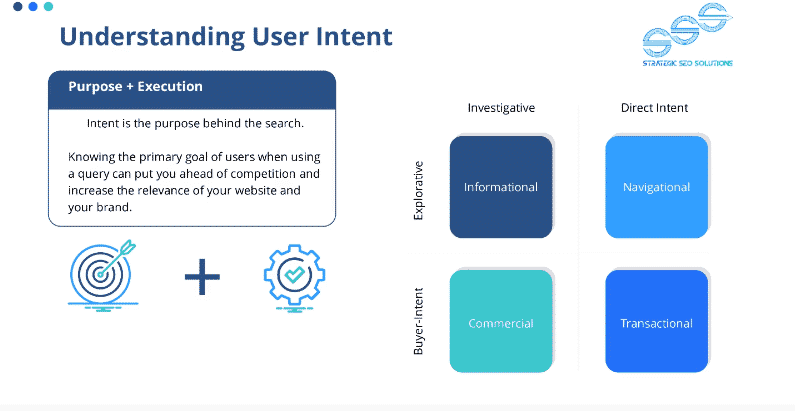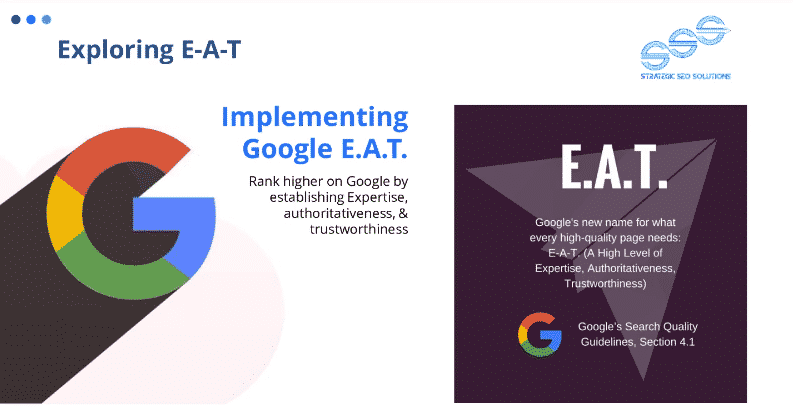“When we think about [SEO] success, we often think about ranking on the first page of Google,” said Jon Lightfoot, founder and CEO of Strategic SEO Solutions, in a recent webinar. “But beyond ranking [at the top], there’s something more [important], which is ranking for the right keywords.”
Ranking for the topics your target audience is searching for doesn’t come from keyword stuffing or overemphasizing keyword density. Success in this area relies on crafting quality content that audiences love and search engines recognize as authoritative.
Here are three effective content strategies Lightfoot recommends marketers enact to support SEO success.
1. Identify user intent
“Intent is the purpose behind the [user’s] search,” Lightfoot said. “There are four buckets to understand and nurture when it comes to your strategy.”
The four areas of user intent he identified relate to specific content or services searchers are looking for. They are as follows:
- Informational: Searchers looking for information, such as an answer to a question.
- Navigational: Users looking for a specific website.
- Commercial: People researching a product or service.
- Transactional: Those who are searching for products or services to purchase.

“How do we harness this and use it in a way that’s effective for our companies? The first step is to perform keyword analysis,” he said. “The epicenter of this is understanding what people want to receive from these queries so you can then create the content that serves them.”
Analyzing keyword data to glean user intent means looking at more than just volume. It requires a thorough analysis of the types of content those words and phrases bring up in the search results and getting a sense of what audiences want from these searches.
function getCookie(cname) {
let name = cname + “=”;
let decodedCookie = decodeURIComponent(document.cookie);
let ca = decodedCookie.split(‘;’);
for(let i = 0; i <ca.length; i++) {
let c = ca[i];
while (c.charAt(0) == ' ') {
c = c.substring(1);
}
if (c.indexOf(name) == 0) {
return c.substring(name.length, c.length);
}
}
return "";
}
document.getElementById('munchkinCookieInline').value = getCookie('_mkto_trk');
2. Prioritize content quality, not quantity
“If you rank at the top of search, that’s only part of the battle,” Lightfoot said. “The real battle is staying there. You have to be mindful of content quality signals.”
Metrics such as bounce rate, time spent on page, number of page views, while telling little by themselves, can give marketers more context into user behavior when analyzed together. They can show how engaged readers are with your content, letting you know which pieces need to be reworked or scrapped altogether.
“It’s about [optimizing] in a qualitative way so that we nurture the core metrics and Google rewards us by maintaining our rankings,” Lightfoot said.
Instead of focusing on pushing out loads of articles, marketers should spend more time improving the quality of the content they’re already producing. This means making the most important on-page elements as well-written and user-centric as possible.
Here’s how SEOs can improve the content quality in a few of these areas.
- Page titles: Use target keywords in the title element, placing the primary terms in the front. Craft them in ways similar to competitors that are performing well in search.
- Heading tags: This element defines your page’s body text, so make it specific to that information.
- Internal linking: Use descriptive, keyword-rich anchor text to prompt readers to explore relevant pages on your site.
3. Focus on E-A-T through external linking and footnotes
“E-A-T – building expertise, authoritativeness, and trustworthiness – is going to come from not only the things you say but the areas that can support what you’re saying,” Lightfoot said. “If you use external linking to provide more information to users, it shows that what you’re saying is validated by other sources.”
“Linking to trustworthy sites proves your value and credentials,” he added.

Linking to authoritative external sources shows readers you took the time to make your content the best it can be, especially when that content is linked with relevant anchor text. But more than that, this process helps improve your own content’s credentials.
Lightfoot also recommends providing additional information with footnotes, which many sites fail to include. Incorporating these resources adds more contextual content to your articles and shows that the data is coming from trustworthy sources.

“Footnotes are great ways to fortify your content, building that expertise, authoritativeness, and trustworthiness, and Google certainly celebrates it,” he said.
Watch this webinar presentation at Digital Marketing Depot.
The post 3 content marketing strategies to support SEO success appeared first on Search Engine Land.
Source: Search Engine Land

